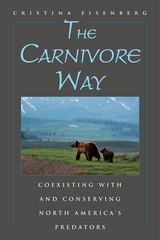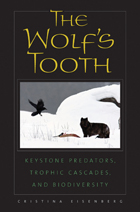2 books by Eisenberg, Cristina

The Carnivore Way
Coexisting with and Conserving North America's Predators
Cristina Eisenberg
Island Press, 2014
What would it be like to live in a world with no predators roaming our landscapes? Would their elimination, which humans have sought with ever greater urgency in recent times, bring about a pastoral, peaceful human civilization? Or in fact is their existence critical to our own, and do we need to be doing more to assure their health and the health of the landscapes they need to thrive?
In The Carnivore Way, Cristina Eisenberg argues compellingly for the necessity of top predators in large, undisturbed landscapes, and how a continental-long corridor—a “carnivore way”—provides the room they need to roam and connected landscapes that allow them to disperse. Eisenberg follows the footsteps of six large carnivores—wolves, grizzly bears, lynx, jaguars, wolverines, and cougars—on a 7,500-mile wildlife corridor from Alaska to Mexico along the Rocky Mountains. Backed by robust science, she shows how their well-being is a critical factor in sustaining healthy landscapes and how it is possible for humans and large carnivores to coexist peacefully and even to thrive.
[more]

The Wolf's Tooth
Keystone Predators, Trophic Cascades, and Biodiversity
Cristina Eisenberg
Island Press, 2010
Animals such as wolves, sea otters, and sharks exert a disproportionate influence on their environment; dramatic ecological consequences can result when they are removed from—or returned to—an ecosystem.
In The Wolf's Tooth, scientist and author Cristina Eisenberg explores the concept of "trophic cascades" and the role of top predators in regulating ecosystems. Her fascinating and wide-ranging work provides clear explanations of the science surrounding keystone predators and considers how this notion can help provide practical solutions for restoring ecosystem health and functioning.
Eisenberg examines both general concepts and specific issues, sharing accounts from her own fieldwork to illustrate and bring to life the ideas she presents. She considers how resource managers can use knowledge about trophic cascades to guide recovery efforts, including how this science can be applied to move forward the bold vision of rewilding the North American continent. In the end, the author provides her own recommendations for local and landscape-scale applications of what has been learned about interactive food webs.
At their most fundamental level, trophic cascades are powerful stories about ecosystem processes—of predators and their prey, of what it takes to survive in a landscape, of the flow of nutrients. The Wolf's Tooth is the first book to focus on the vital connection between trophic cascades and restoring biodiversity and habitats, and to do so in a way that is accessible to a diverse readership.
In The Wolf's Tooth, scientist and author Cristina Eisenberg explores the concept of "trophic cascades" and the role of top predators in regulating ecosystems. Her fascinating and wide-ranging work provides clear explanations of the science surrounding keystone predators and considers how this notion can help provide practical solutions for restoring ecosystem health and functioning.
Eisenberg examines both general concepts and specific issues, sharing accounts from her own fieldwork to illustrate and bring to life the ideas she presents. She considers how resource managers can use knowledge about trophic cascades to guide recovery efforts, including how this science can be applied to move forward the bold vision of rewilding the North American continent. In the end, the author provides her own recommendations for local and landscape-scale applications of what has been learned about interactive food webs.
At their most fundamental level, trophic cascades are powerful stories about ecosystem processes—of predators and their prey, of what it takes to survive in a landscape, of the flow of nutrients. The Wolf's Tooth is the first book to focus on the vital connection between trophic cascades and restoring biodiversity and habitats, and to do so in a way that is accessible to a diverse readership.
[more]
READERS
Browse our collection.
PUBLISHERS
See BiblioVault's publisher services.
STUDENT SERVICES
Files for college accessibility offices.
UChicago Accessibility Resources
home | accessibility | search | about | contact us
BiblioVault ® 2001 - 2024
The University of Chicago Press









